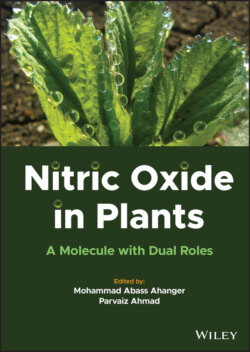Читать книгу Nitric Oxide in Plants - Группа авторов - Страница 20
2.1 Introduction
ОглавлениеNitrogen monoxide/nitric oxide (NO) is a small, fat-soluble gaseous radical that has been well recognized for a long period to be involved in the nitrogen cycle (Jedelská et al. 2021). Earlier it was considered a gaseous free radical and toxic air pollutant (Gupta et al. 2011; Astier et al. 2018). However, over the past 30 years, NO has turned out to be the center of many biological processes in animals and plants as it has been reported as a signaling molecule. This has shifted research interest and understanding of NO as a noxious by-product to it being seen as an important molecule. NO has multiple functions at diverse levels including chemical, cellular, organ, and tissue (Santolini et al. 2017; Corpas et al. 2019; Vishwakarma et al. 2019). In animals, NO acts as a vital regulator and plays an important role in reproduction; while, in plants, it is involved in various functional developments, for instance, germination, seed dormancy (Probert 2000; Bethke et al. 2006; Arc et al. 2013; Nagel et al. 2019), defense responses, flowering/leaf senescence, and protection against environmental stresses (Lora et al. 2019; Abedi et al. 2021).
Nitric oxide is available as three exchangeable species: the cation of nitrosonium (NO+), NO, and the anion of nitroxyl (NO−) (Butler et al. 1995). It is water soluble and by the addition of ferrous salts, its solubility is enhanced. Therefore, it can easily diffuse in the aqueous part of a cell including the cytoplasm, and also can freely move through the lipid bilayer. It is believed that once it is produced, it can move to the adjacent cells (Del Río et al. 2004; Delledonne 2005).
